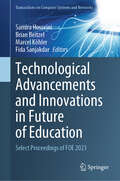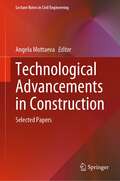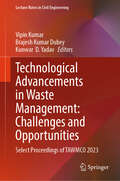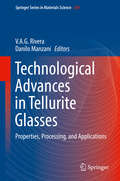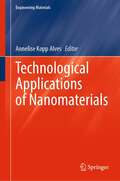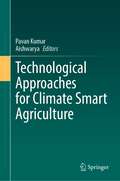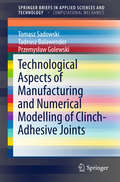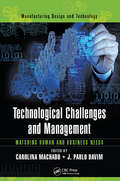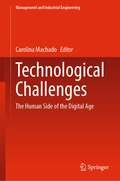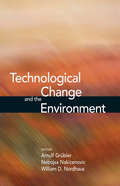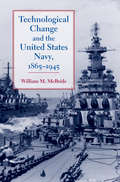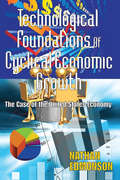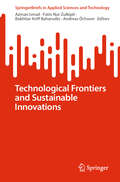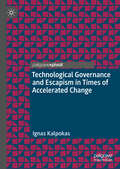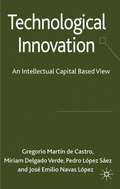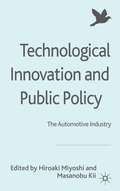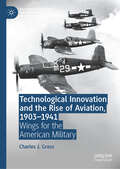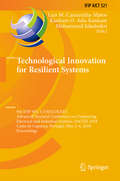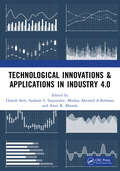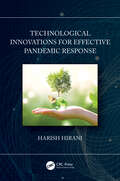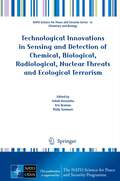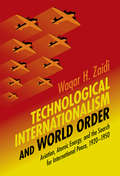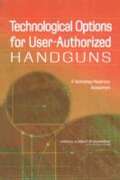- Table View
- List View
Technological Advancements and Innovations in Future of Education: Select Proceedings of FOE 2023 (Transactions on Computer Systems and Networks)
by Samira Hosseini Fida Sanjakdar Brian Beitzel Marcel KöhlerThis book contains peer-reviewed selected papers from the 6th International Conference on the Future of Education (FOE 2023). It presents excellent educational practices and technologies complemented by various innovative approaches that enhance educational outcomes. The conference, in particular, places great attention on solutions to educational problems that are highly aligned with four Sustainable Development Goals from the seventeen goals designed by UNESCO. The book focuses on quality education, industry, innovation, and infrastructure, reduced inequalities, etc. The FOE 2023 proceedings offer contributions covering a diverse range of innovations and technology in education and how they may facilitate the current stages of education and shape future avenues for offering quality and accessible education. Moreover, the articles presented in this book present dynamic computing and pedagogical approaches to empower learners and educators across the globe. As our planet continues to tackle international crises including poverty, climate change, limited access to technological tools, and global pandemics, remote and/or online teaching and learning find paramount importance, which has also been considered a powerful theme in the presented articles. These essential components highly contribute to reduced inequalities serving learners from higher education levels to lifelong learners while playing a crucial role in closing the gap between the skill set obtained by the graduates and those demanded by the job market.
Technological Advancements in Construction: Selected Papers (Lecture Notes in Civil Engineering #180)
by Angela MottaevaThe book consists of original research papers in the field of Technological Advancements in Construction. It covers such topics as non-destructive testing, structural health monitoring, innovative composite materials, strengthening and rehabilitation of buildings and structures, seismic resilience of structures, thermal protection of buildings, construction and operation of buildings and structures in extreme climatic conditions, structural dynamics and vibration control, and green construction. The book contains latest information on structural mechanics of composite materials and structures, theoretical and computational modeling of new materials and structures, experimental and numerical analysis in building rehabilitation and strengthening, analytical, numerical and experimental methodologies for the analysis of multilayered structures, and advanced methods for seismic performance evaluation of building structures. The book includes original research and application papers of high academic level, where significant scientific novelty is clearly demonstrated. The book presents a valuable tool for researchers and construction professionals.
Technological Advancements in Waste Management: Select Proceedings of TAWMCO 2023 (Lecture Notes in Civil Engineering #542)
by Vipin Kumar Kunwar D. Yadav Brajesh Kumar DubeyThis book consists of the select proceedings of the National Conference on Technological Advancements in Waste Management: Challenges and Opportunities (TAWMCO) - 2023. The book focuses on the prospective challenges and new emerging opportunities in the field of waste management. It primarily delves into the realm of challenges and nascent opportunities within the sphere of waste management, encompassing diverse facets such as industrial waste, municipal waste, and mining and mineral processing waste. It covers recent research in waste upcycling, transformation, recycling and methodical disposal, with a particular emphasis on cutting-edge technologies that underpin the sustainable management of waste. An integral component of this compilation is the exploration of technological breakthroughs in the realm of waste-to-energy. This book is poised to become an invaluable resource for scholars, researchers and seasoned professionals engaged in the field of waste management and allied disciplines.
Technological Advances in Tellurite Glasses
by V. A. G. Rivera Danilo ManzaniThis book is the first to provide a comprehensive introduction to the synthesis, optical properties, and photonics applications of tellurite glasses. The book begins with an overview of tellurite glasses, followed by expert chapters on synthesis, properties, and state-of-the-art applications ranging from laser glass, optical fibers, and optical communications through color tuning, plasmonics, supercontinuum generation, and other photonic devices. The book provides in-depth information on the the structural, linear, and non-linear optical properties of tellurite glasses and their implications for device development. Real-world examples give the reader valuable insight into the applications of tellurite glass. A detailed discussion of glass production methods, including raw materials and melting and refining oxide- and fluoro-tellurite glasses, is also included. The book features an extensive reference list for further reading. This highly readable and didactic text draws on chemical composition, glass science, quantum mechanics, and electrodynamics. It is suitable for both advanced undergraduate and graduate students as well as practicing researchers.
Technological Applications of Nanomaterials (Engineering Materials)
by Annelise Kopp AlvesThis book contains an overview of novel synthesis, characterization, and applications of nanomaterials. Based on an extensive state-of-the-art literature survey and results obtained from researches during the past years, this book presents techniques and special applications of classical and modern nanomaterials. This book reviews different nanomaterials, from the synthesis and characterization of diverse materials to modern applications such as viral detection, hyperthermia, thermoelectric, nano-coatings, electrochromic, pigments, among others. This book is aimed at students, researchers, and engineers who seek general scientific knowledge about nanomaterials with an application-oriented approach.
Technological Approaches for Climate Smart Agriculture
by Pavan Kumar AishwaryaThis volume presents up-to-date information on technological advancements in climate smart farming systems, covering crop modeling, irrigation practices, spatial modeling and agricultural policy in the context of climate change. The book presents the main applications in climate smart agriculture through technological approaches including the primary agricultural dynamics, mitigation strategies for sustainable soil and crop security, climate smart solutions to improve soil health, and crop and livestock productivity. It will be useful for scientists, environmentalists, meteorologists, environmental consultants, and computing experts working in the areas of climate-smart agriculture though technological approaches.
Technological Aspects of Manufacturing and Numerical Modelling of Clinch-Adhesive Joints
by Tomasz Sadowski Tadeusz Balawender Przemysław GolewskiThis short book describes the basic technological aspects involved in the creation of purely clinch and clinch-adhesive joints made of different types of adherent materials and employing different joining technologies. Basic parameters that need to be taken into account in the design process are also presented, while a comparison of experimental testing of the hybrid joint with simple clinching for a combination of different joining materials underlines the advantages of opting for hybrid joints. The book's conclusions will facilitate the practical application of this new fastening technology.
Technological Challenges and Management: Matching Human and Business Needs (Manufacturing Design And Technology Ser. #2)
by J. Paulo Davim Carolina MachadoToday's organizations find themselves in a race to adopt new technologies in order to keep up with their competition. However, two questions must be answered: Are these organizations ready for new technological advancements, and are these new technologies appropriate for every organization? Technological Challenges and Management: Matching Human an
Technological Challenges: The Human Side of the Digital Age (Management and Industrial Engineering)
by Carolina MachadoThis book discusses and exchanges information on principles, strategies, models, techniques, methodologies and applications of technological challenges in a digital era. It helps the reader to develop the skills required in the digital age and to acquire the knowledge and know-how necessary to drive their organizations to success. This book presents contributions that are exceptional in terms of theory and/or practice in the area of human resources management, technological management, digital age, creativity, technological innovation, organizational innovation, business analytics and flexibility.
Technological Change and the Environment
by Nebojsa Nakicenovic William D. Nordhaus Arnulf GrüblerMuch is written in the popular literature about the current pace of technological change. But do we have enough scientific knowledge about the sources and management of innovation to properly inform policymaking in technology dependent domains such as energy and the environment? While it is agreed that technological change does not 'fall from heaven like autumn leaves,' the theory, data, and models are deficient. The specific mechanisms that govern the rate and direction of inventive activity, the drivers and scope for incremental improvements that occur during technology diffusion, and the spillover effects that cross-fertilize technological innovations remain poorly understood. In a work that will interest serious readers of history, policy, and economics, the editors and their distinguished contributors offer a unique, single volume overview of the theoretical and empirical work on technological change. Beginning with a survey of existing research, they provide analysis and case studies in contexts such as medicine, agriculture, and power generation, paying particular attention to what technological change means for efficiency, productivity, and reduced environmental impacts. The book includes a historical analysis of technological change, an examination of the overall direction of technological change, and general theories about the sources of change. The contributors empirically test hypotheses of induced innovation and theories of institutional innovation. They propose ways to model induced technological change and evaluate its impact, and they consider issues such as uncertainty in technology returns, technology crossover effects, and clustering. A copublication o Resources for the Future (RFF) and the International Institute for Applied Systems Analysis (IIASA).
Technological Change and the United States Navy, 1865–1945 (Johns Hopkins Studies in the History of Technology #27)
by William M. McBrideWinner, Engineer-Historian Award from the American Society of Mechanical EngineersNavies have always been technologically sophisticated, from the ancient world's trireme galleys and the Age of Sail's ships-of-the-line to the dreadnoughts of World War I and today's nuclear-powered aircraft carriers and submarines. Yet each large technical innovation has met with resistance and even hostility from those officers who, adhering to a familiar warrior ethos, have grown used to a certain style of fighting. In Technological Change and the United States Navy, William M. McBride examines how the navy dealt with technological change—from the end of the Civil War through the "age of the battleship"—as technology became more complex and the nation assumed a global role. Although steam engines generally made their mark in the maritime world by 1865, for example, and proved useful to the Union riverine navy during the Civil War, a backlash within the service later developed against both steam engines and the engineers who ran them. Early in the twentieth century the large dreadnought battleship at first met similar resistance from some officers, including the famous Alfred Thayer Mahan, and their industrial and political allies. During the first half of the twentieth century the battleship exercised a dominant influence on those who developed the nation's strategies and operational plans—at the same time that advances in submarines and fixed-wing aircraft complicated the picture and undermined the battleship's superiority.In any given period, argues McBride, some technologies initially threaten the navy's image of itself. Professional jealousies and insecurities, ignorance, and hidebound traditions arguably influenced the officer corps on matters of technology as much as concerns about national security, and McBride contends that this dynamic persists today. McBride also demonstrates the interplay between technological innovation and other influences on naval adaptability—international commitments, strategic concepts, government-industrial relations, and the constant influence of domestic politics. Challenging technological determinism, he uncovers the conflicting attitudes toward technology that guided naval policy between the end of the Civil War and the dawning of the nuclear age. The evolution and persistence of the "battleship navy," he argues, offer direct insight into the dominance of the aircraft-carrier paradigm after 1945 and into the twenty-first century.
Technological Foundations of Cyclical Economic Growth: The Case of the United States Economy
by Nathan EdmonsonNew technology is intimately associated with increased economic growth. The tools people have and when they acquired them tells us much about cyclical patterns of growth. Those interested in encouraging economic growth would do well to look to the conditions that spur the origins, development, and impact of technology - as well as the circumstances that spur prolific periods of invention, the mother of technology. Despite general recognition of the connection between technology and growth, economists rarely have gotten to the heart of the relationship. Joseph Schumpeter and John Hicks were aware of the role of technology in cyclical variability, but their thoughts were not elaborated upon after they passed from the scene. Edmonson goes beyond formal theory, reviewing the record of economic growth and the role of technology in this growth. What does the technology future hold? One clue is where past prototype inventions that that have fomented massive technological innovations have come from. Some parts of the private sector, such as Bell Labs, have been important. The government, particularly in its sponsorship of defense related research, has delivered a number of inventions. Universities are very much in the picture in certain fields, such as nanotechnology. The challenges we face at the onset of the twenty-first century are covered in depth and with imagination by Edmonson. The book will spur much rethinking about economic futures.
Technological Frontiers and Sustainable Innovations (SpringerBriefs in Applied Sciences and Technology)
by Andreas Öchsner Azman Ismail Fatin Nur Zulkipli Bakhtiar Ariff BaharudinThis book takes a deep dive into the industrial sphere, exploring subjects such as aerospace development, knowledge management in higher education, and the emergence of a nation as a player in the global space race. This insightful compilation of chapters offers an essential guide to navigating the complexities of modern industry, offering valuable insights and solutions to propel businesses and society toward a sustainable future.
Technological Governance and Escapism in Times of Accelerated Change (Information Technology and Global Governance)
by Ignas KalpokasThis book examines escapist coping strategies brought about by the pace, breadth and governance of technological change. It argues that escapism manifests in various forms, ranging from nostalgia for a fantasised past of unhindered reason and agency, to progressive visions of societal and political improvement, and greater empowerment. Drawing on post-humanist theory and critical disability studies, the book also assesses how escapism should not be viewed as an unavoidable reaction to technological change, and develops a model for an ethically equitable relationship between humans and technology. It will appeal to all those interested in governance and politics, media and communication studies, technology studies, and philosophy.
Technological Innovation
by Gregorio Martín de Castro Miriam Delgado Verde Pedro López Sáez José Emilio Navas LópezConsidering the uncertain, competitive and dynamic current environment, the capability to create and apply new knowledge represents one of the main sources of sustained competitive advantage (Teece, 1998; Nonaka, 1991; Almeida, Song& Grant, 2002). Intellectual capital stocks, as well as their different manifestations play a critical role for effective development of the firm technological innovation (Teece, 1998; Subramaniam and Youndt, 2005). Wedevelop an improved and extended theoretical and empirical propositions about it can labeled 'An Intellectual Capital Based-View of Technological Innovation'. The book is about the role of knowledge stocks or intellectual capital blocks (human, structural, and relational capital) on two technological innovation processes typologies (process/product). This method obtains evidence-driven models that depict the nature of innovation management, since it is shown the significant and positive influence of each intellectual capital components on product and process innovation. "
Technological Innovation and Public Policy: The Automotive Industry (Palgrave Macmillan Asian Business Series)
by Hiroaki Miyoshi Masanobu KiiTechnological innovation is a necessary but insufficient ingredient for solving the problems of society caused by the widespread use of automobiles. For this reason, a host of public-policy solutions have been devised and implemented - with varying results - to maximize the efficacy of innovative automotive technologies in combating societal ills. Focusing on safety and environmental protection issues, this book provides incisive, cutting-edge theoretical analysis that evaluates the impact of new automotive technologies and the associated public policies on social welfare. It discusses how new automotive technologies can improve social welfare and why public policies are needed to promote the adoption of these technologies. The contributors analyze taxes, subsidies, and regulations - and the decision-making processes behind them - to identify policy directions that optimize the social benefits of emerging automobile technologies. The reader will gain an appreciation of how policies can break down barriers and exploit market innovations for the common good.
Technological Innovation and the Rise of Aviation, 1903-1941: Wings for the American Military (Palgrave Studies in the History of Science and Technology)
by Charles J. GrossThis book provides an overview of American aviation from 1903 to 1941, covering major developments in aviation technology. It focuses on the role of the military and selected firms. Under the fiscal constraints imposed by the post-war military drawdown and the Great Depression, the US military sacrificed quantity aircraft procurement for gains in quality. Until foreign powers began huge rearmament programs, US military aircraft were some of the most advanced in the world. They held numerous international performance records before the US fell behind other powers that had gone on a war footing. It offers new insights into the contributions of immigrants and foreign technologies to American aviation, while examining the relationship between the government and the aviation industry. It also highlights factors that enabled America to field some of the war’s most advanced warplanes, which ultimately helped win the Second World War.
Technological Innovation for Resilient Systems: 9th Ifip Wg 5. 5/socolnet Advanced Doctoral Conference On Computing, Electrical And Industrial Systems, Doceis 2018, Costa De Caparica, Portugal, May 2-4, 2018, Proceedings (IFIP Advances in Information and Communication Technology #521)
by Luis M. Camarinha-Matos Kankam O. Adu-Kankam Mohammad JulashokriThis book constitutes the refereed proceedings of the 9th IFIP WG 5.5/SOCOLNET Advanced Doctoral Conference on Computing, Electrical and Industrial Systems, DoCEIS 2018, held in Costa de Caparica, Portugal, in May 2018. The 30 revised full papers presented were carefully reviewed and selected from 74 submissions. The papers present selected results produced in engineering doctoral programs and focus on technological innovation for resilient systems. Research results and ongoing work are presented, illustrated and discussed in the following areas: collaborative systems, decision support systems, supervision systems, energy management, smart grids, sensing systems, electrical systems, simulation and analysis, monitoring systems, and energy distribution systems.
Technological Innovations & Applications in Industry 4.0
by Dinesh Seth Sushant S. Satputaley Minhaj Ahemad A. Rehman Amit R. BhendeThe conference offered an international forum for discussion and exchange of knowledge on opportunities and challenges related with all facets and aspects of technological innovations & applications in Industry 4.0, its challenges and way ahead. The objective of this international conference was to provide a platform for policy makers, academicians and researchers to share their experiences and knowledge by presentation of scientific advances made in the field of Industry 4.0.
Technological Innovations for Effective Pandemic Response
by Harish HiraniThis reference text discusses the potential of efficient R&D management during times of pandemic crisis and how it can provide time-bound real-life deliverables to ward-off the contamination-linked vulnerability aspects of social interaction. It discusses important topics including mechanical ventilator with oxygen enrichment, hospital waste management facility, hospital care assistive robotic devices, implementation of smart manufacturing, special purpose machines, micro machining, 3D printing, disposal of plastic waste utilizing high temperature plasma, automatic biomass briquetting plant, and fully automatic biodiesel plant. Features: Discusses novel technological innovations developed especially to effectively counter pandemics such as COVID 19. Explores how R&D modelling of technology can be interspersed with socio-economic values. Covers how innovative technological solutions can be developed as per the situational requisites and deployed in the least possible time to make maximum impact. Discusses industrial manufacturing and automation techniques. The text will be useful for graduate students, and academic researchers working in diverse areas such as mechanical engineering, industrial engineering, production engineering, manufacturing science, and automobile engineering. It covers influences of Pandemics on water and sanitation services, floating capsule-based biofilm reactor (FCBBR) methodology, and innovative segregation of waste through a mechanized model.
Technological Innovations in Sensing and Detection of Chemical, Biological, Radiological, Nuclear Threats and Ecological Terrorism
by Ashok Vaseashta Eric Braman Philip SusmannThis book arises from the NATO Advanced Study Institute "Technological Innovations in Detection and Sensing of CBRN Agents and Ecological Terrorism" held in Chisinau, Republic of Moldova in June 2010. It comprises a variety of invited contributions by highly experienced educators, scientists, and industrialists, and is structured to cover important aspects of the field that include developments in chemical-biological, and radiation sensing, synthesis and processing of sensors, and applications of sensors in detecting/monitoring contaminants introduced/dispersed inadvertently or intentionally in air, water, and food supplies. The book emphasizes nanomaterials and nanotechnology based sensing and also includes a section on sensing and detection technologies that can be applied to information security. Finally, it examines regional, national, and international policies and ethics related to nanomaterials and sensing. It will be of considerable interest and value to those already pursuing or considering careers in the field of nanostructured materials and nanotechnology based sensing, In general, it serves as a valuable source of information for those interested in how nanomaterials and nanotechnologies are advancing the field of sensing, detection, and remediation, policy makers, and commanders in the field.
Technological Innovations in Tropical Livestock Development for Environmental Sustainability and Food Security: Proceedings of the 4th International Conference on Improving Tropical Animal Production for Food Security (ITAPS 2023), 4–5 December 2023, Kendari, Indonesia
by Purnaning Dhian Isnaeni Mashitah Shikh Maidin Muh. Amrullah Pagala Widhi Kurniawan Asma Bio KimestriThis book contains the proceedings of the fourth International Conference on Tropical Animal Production for Food Security (ITAPS) exploring Technological Innovations in Tropical Livestock Development for Environmental Sustainability and Food Security.It discusses two interconnected issues: tropical livestock farming and environmental concerns, while addressing the adoption of innovative technologies and sustainable farming practices as a crucial step in addressing challenges related to tropical livestock farming. The contents of the proceedings include the latest research that can be applied in agricultural fields to improve the agriculture business, including topics such as: Leveraging environmentally friendly technologies to enhance production efficiency, manage waste effectively, and reduce carbon footprints Halal meat production in the modern era Availability of animal waste resources as alternative energy The book will be valuable to students, researchers, and professionals in the agricultural fields and science.
Technological Internationalism and World Order: Aviation, Atomic Energy, and the Search for International Peace, 1920–1950 (Science in History)
by Waqar H. ZaidiBetween 1920 and 1950, British and US internationalists called for aviation and atomic energy to be taken out of the hands of nation-states, and instead used by international organizations such as the League of Nations and the United Nations. An international air force was to enforce collective security and internationalized civil aviation was to bind the world together through trade and communication. The bomber and the atomic bomb, now associated with death and devastation, were to be instruments of world peace. Drawing on rich archival research and focusing on public and private discourse relating to the control of aviation and atomic energy, Waqar H. Zaidi highlights neglected technological and militaristic strands in twentieth-century liberal internationalism, and transforms our understanding of the place of science and technology in twentieth-century international relations.
Technological Options for User-Authorized HANDGUNS: A Technology-Readiness Assessment
by National Academy of Engineering of the National AcademiesThe National Academies Press (NAP)--publisher for the National Academies--publishes more than 200 books a year offering the most authoritative views, definitive information, and groundbreaking recommendations on a wide range of topics in science, engineering, and health. Our books are unique in that they are authored by the nation's leading experts in every scientific field.
Technological Paradigms and Digital Eras: Data-driven Visions for Building Design (PoliTO Springer Series)
by Giacomo ChiesaThe book connects the ICT and the architectural worlds, analyzing modeling, materialization and data-driven visions for design issues at different scales. Furthermore, using sample modeling and materialization tools, it explores the links between performance-driven design approaches and the application of new digital technologies. Intended for architects and urbanists, it provides a theoretical framework to address the implications of the digital revolution in building design and operation. Furthermore, combining insights from IT and ICT with architectural and urban design know-how, it offers engineering professionals a technology-driven interpretation of the building design field.
